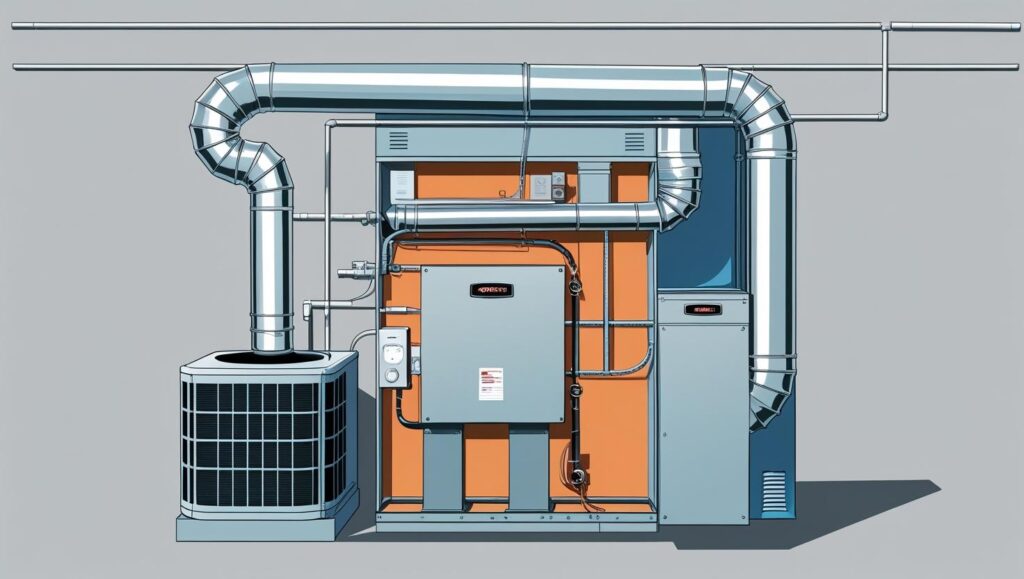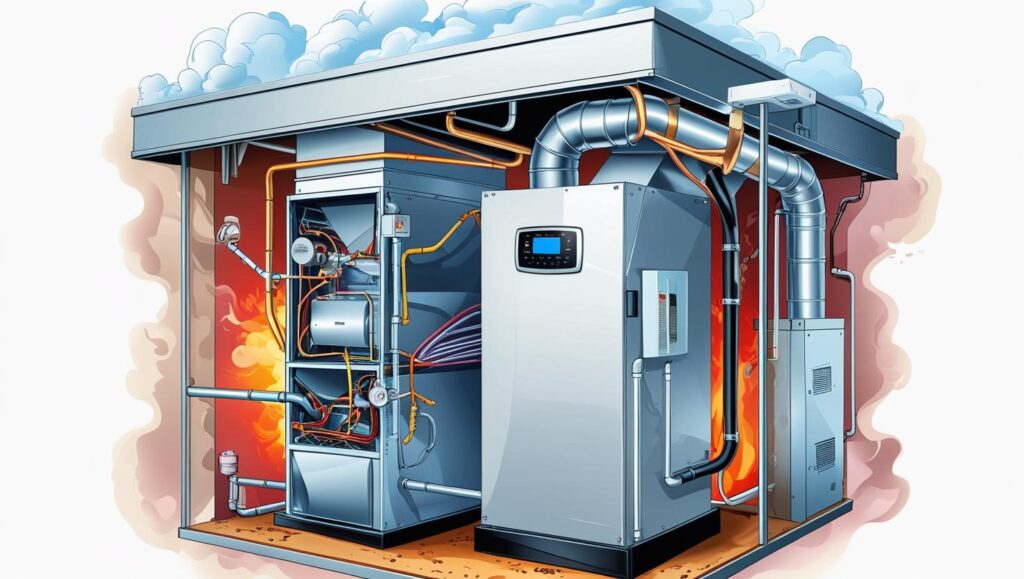The global Heating and Air Conditioning System Market is undergoing a profound transformation, driven by an intricate interplay of technological advancements, escalating energy efficiency demands, and evolving environmental regulations. As societies worldwide continue to prioritize comfort, health, and sustainability, the demand for sophisticated heating and air conditioning systems is experiencing a robust and sustained upward trajectory. This comprehensive exploration delves deeply into the multifaceted aspects of the Heating and Air Conditioning System Market, dissecting its current state, identifying crucial growth catalysts, examining regional dynamics, and forecasting its promising future. Understanding the intricate nuances of the Heating and Air Conditioning System Market is paramount for businesses, consumers, and policymakers alike, as it plays a pivotal role in shaping our built environment and influencing global energy consumption patterns.

Understanding the Core Components of the Heating and Air Conditioning System Market
The Heating and Air Conditioning System Market encompasses a broad spectrum of equipment and services designed to regulate indoor temperatures and air quality. This includes, but is not limited to, air conditioners, furnaces, heat pumps, boilers, ventilation systems, air handling units, chillers, and cooling towers. Each component contributes to creating comfortable, healthy, and productive indoor environments, whether in residential dwellings, commercial establishments, or industrial facilities. The increasing complexity and integration of these systems, often augmented by smart technologies, underscore the continuous innovation within the Heating and Air Conditioning System Market. The traditional notion of simple heating and cooling has expanded to embrace holistic indoor climate management, directly influencing the growth trajectory of the Heating and Air Conditioning System Market.
Analyzing the Current Size and Projections of the Heating and Air Conditioning System Market
The global Heating and Air Conditioning System Market is a substantial and rapidly expanding sector. The residential segment, driven by new housing projects and rising disposable incomes, holds a significant share, while commercial and industrial applications also contribute substantially to the overall Heating and Air Conditioning System Market. The demand for energy-efficient and sustainable heating and air conditioning solutions is a primary driving force behind these impressive market figures.
Key Driving Forces Propelling the Growth of the Heating and Air Conditioning System Market
The sustained expansion of the Heating and Air Conditioning System Market is underpinned by several powerful growth drivers. A fundamental factor is the burgeoning global population and the accompanying surge in construction activities, particularly in urban areas. As more residential and commercial buildings are erected, the inherent need for effective heating and air conditioning systems escalates. Furthermore, rising disposable incomes in developing economies are empowering a larger segment of the population to invest in comfort-enhancing appliances, directly fueling the demand within the Heating and Air Conditioning System Market.
Another significant driver is the growing awareness and concern regarding indoor air quality (IAQ). The COVID-19 pandemic further amplified the importance of healthy indoor environments, leading to increased adoption of advanced filtration, ventilation, and purification technologies integrated within heating and air conditioning systems. This heightened focus on health and well-being is a strong catalyst for innovation and growth across the entire Heating and Air Conditioning System Market.
Moreover, the imperative for energy efficiency and environmental sustainability is profoundly reshaping the Heating and Air Conditioning System Market. Stricter government regulations and mandates promoting lower energy consumption and reduced carbon emissions are compelling manufacturers to develop and deploy more efficient and eco-friendly solutions. This includes the widespread adoption of heat pumps, which offer superior energy efficiency compared to traditional heating and cooling methods, and the transition to refrigerants with lower global warming potential. The confluence of these factors is steering the Heating and Air Conditioning System Market towards a more sustainable and technologically advanced future.
Emerging Technologies and Innovations Reshaping the Heating and Air Conditioning System Market
The Heating and Air Conditioning System Market is a hotbed of innovation, with several cutting-edge technologies poised to redefine its landscape. Smart HVAC systems, leveraging the power of the Internet of Things (IoT) and Artificial Intelligence (AI), are becoming increasingly prevalent. These intelligent systems can learn user preferences, optimize energy usage based on occupancy and weather conditions, and enable remote monitoring and control, offering unparalleled convenience and energy savings. Predictive maintenance, powered by AI and IoT sensors, is revolutionizing how heating and air conditioning systems are serviced, allowing for proactive problem identification and reduced downtime.
Renewable energy integration is another transformative trend within the Heating and Air Conditioning System Market. The increasing adoption of solar-powered HVAC systems and geothermal heat pumps signifies a significant shift towards sustainable energy sources. These systems harness natural energy to provide efficient heating and cooling, drastically reducing reliance on fossil fuels and lowering operational costs. Variable Refrigerant Flow (VRF) systems, offering precise temperature control and enhanced energy efficiency, are also gaining considerable traction in various applications across the Heating and Air Conditioning System Market. Furthermore, advancements in advanced filtration systems and UV-C sterilization technologies are addressing the heightened demand for superior indoor air quality, contributing to a healthier and more comfortable living and working environment.

Regional Dynamics and Market Analysis of the Heating and Air Conditioning System Market
A detailed regional analysis reveals diverse growth patterns and market characteristics across the global Heating and Air Conditioning System Market. Asia Pacific currently stands as the largest revenue-generating region, primarily due to rapid urbanization, robust construction activities, and increasing disposable incomes in countries like China and India. India, for instance, is projected to be the fastest-growing regional market in Asia Pacific, driven by increasing construction activities, industrialization, and rising product awareness. The demand for space cooling in India alone is expected to increase dramatically in the coming decades, highlighting the immense potential within the Heating and Air Conditioning System Market in this region.
North America, particularly the U.S. and Canada, also holds a significant share of the Heating and Air Conditioning System Market. The growth in this region is attributed to the expansion of urban areas, the presence of industrially developed countries, and stringent regulations related to HVAC system installations. Europe exhibits a diverse Heating and Air Conditioning System Market, with a growing emphasis on energy efficiency and the adoption of heat pumps, driven by ambitious climate targets. Countries like Germany and France are at the forefront of this shift, with government policies encouraging renewable energy integration in heating systems. The Middle East and Africa, influenced by extreme climatic conditions and ongoing infrastructure development, also present substantial opportunities for the expansion of the Heating and Air Conditioning System Market.
Download PDF Brochure @ https://www.marketsandmarkets.com/pdfdownloadNew.asp?id=202111288
Navigating the Competitive Landscape of the Heating and Air Conditioning System Market
The Heating and Air Conditioning System Market is characterized by intense competition among a mix of global conglomerates and regional specialists. Leading players such as Daikin Industries, Carrier Global Corporation, Trane Technologies, Johnson Controls International, Lennox International, Mitsubishi Electric Corporation, and LG Electronics are continually innovating and expanding their product portfolios. These companies are investing heavily in research and development to introduce more energy-efficient, smart, and environmentally friendly solutions.
The competitive landscape is also shaped by strategic collaborations, mergers, and acquisitions, as companies seek to strengthen their market position and expand their geographical reach. For instance, acquisitions aimed at enhancing smart HVAC technology portfolios demonstrate the strategic intent of major players in the Heating and Air Conditioning System Market. The focus on customer service, after-sales support, and comprehensive maintenance plans is becoming increasingly crucial for sustained success in this highly competitive arena. The ability to adapt to evolving consumer demands and regulatory frameworks will be a key differentiator for companies operating within the Heating and Air Conditioning System Market.
Challenges and Opportunities within the Heating and Air Conditioning System Market
Despite its promising growth trajectory, the Heating and Air Conditioning System Market faces several challenges. High initial installation costs can deter consumers from upgrading to more efficient systems, particularly in economically challenged regions. The industry also grapples with a skilled labor shortage, as experienced technicians retire and the influx of new talent struggles to keep pace with technological advancements. Furthermore, the volatility in raw material prices can impact profit margins for manufacturers and service providers within the Heating and Air Conditioning System Market. The increasing complexity of modern systems also necessitates continuous training and upskilling of the workforce.
However, these challenges also present significant opportunities. The rising demand for retrofitting and upgrading existing HVAC infrastructure offers a substantial market segment. The increasing integration of Building Automation Systems (BAS) provides centralized control and energy management capabilities for commercial and industrial buildings. The emphasis on predictive maintenance and remote monitoring opens new avenues for service providers to offer proactive and efficient support. Moreover, the accelerating global shift towards a low-carbon economy creates immense opportunities for manufacturers to develop and market sustainable, energy-efficient heating and air conditioning solutions, aligning with global climate goals and securing a prominent position within the evolving Heating and Air Conditioning System Market.
The Future Outlook for the Heating and Air Conditioning System Market
The future of the Heating and Air Conditioning System Market appears exceptionally bright, driven by an unwavering commitment to energy efficiency, environmental sustainability, and enhanced indoor comfort. The continued integration of advanced digital technologies like AI, IoT, and machine learning will lead to even more intelligent and autonomous HVAC systems, optimizing performance and minimizing energy consumption. The adoption of heat pumps and other renewable energy-powered solutions is expected to accelerate globally, further reducing the carbon footprint of the built environment.
Furthermore, increasing awareness of the impact of climate change and the growing frequency of extreme weather events will underscore the critical role of robust and resilient heating and air conditioning systems. The focus will extend beyond mere temperature control to comprehensive indoor environmental quality, encompassing humidity control, advanced air filtration, and smart ventilation. As urban populations continue to grow and economies develop, the fundamental need for comfortable and healthy indoor spaces will ensure that the Heating and Air Conditioning System Market remains a vital and dynamic industry, continuously evolving to meet the complex demands of a changing world.
Frequently Asked Questions about the Heating and Air Conditioning System Market
Which region currently dominates the Heating and Air Conditioning System Market?
Asia Pacific currently holds the largest revenue share in the global Heating and Air Conditioning System Market, primarily driven by rapid urbanization and significant construction activities.
What are the primary drivers for the growth of the Heating and Air Conditioning System Market?
Key drivers include increasing global population and construction activities, rising disposable incomes, growing concerns about indoor air quality, and stringent energy efficiency regulations.
What emerging technologies are impacting the Heating and Air Conditioning System Market?
Emerging technologies include smart HVAC systems leveraging IoT and AI, renewable energy integration (solar, geothermal), advanced filtration systems, and Variable Refrigerant Flow (VRF) systems.
What are some of the challenges faced by the Heating and Air Conditioning System Market?
Challenges include high initial installation costs, a shortage of skilled labor, and fluctuations in raw material prices.
How does climate change influence the Heating and Air Conditioning System Market?
Climate change leads to increased demand for cooling in many regions due to rising temperatures and more frequent heatwaves, driving innovation in energy-efficient cooling solutions within the Heating and Air Conditioning System Market.
What role do heat pumps play in the modern Heating and Air Conditioning System Market?
Heat pumps are becoming increasingly popular due to their superior energy efficiency and ability to provide both heating and cooling, contributing significantly to the sustainability goals within the Heating and Air Conditioning System Market.
Are there new refrigerants being adopted in the Heating and Air Conditioning System Market? Y
es, the industry is transitioning to environmentally friendly refrigerants with lower Global Warming Potential (GWP) to reduce the environmental impact of heating and air conditioning systems.